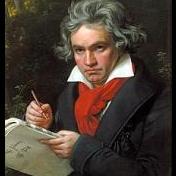Search the Community
Showing results for tags 'beethoven'.
-
A wonderful video sprang across my YouTube feed a few days ago. All the information in the video was news to me -- essentially, the claim is that we've been playing the Beethoven "Moonlight Sonata" the wrong way for two centuries, inspired by a poor nickname that really doesn't fit the piece at all! The professor's fresh interpretation of the first movement at the end of the video suddenly inspired me to try to orchestrate the piece, as I was having a lot of interesting ideas I thought I might try in order to create a really unorthodox interpretation. Before this week I had always thought Moonlight was a sort of cliched piece, but the professor brought it back to life and showed me it's famous for a reason.... The work was surprisingly quick, even though I was also trying Musescore 4 for the first time. Figured I'd give it a whirl on a short side project rather than a main composition. (Spoiler: it's actually pretty awesome. The sounds are amazing.) My overall aim was to recreate some of the tragic funeral march character that is usually lost in most modern interpretations, but also to emulate the "ghostly" quality of which Carl Czerny spoke. I've accordingly created more active, dense, even "smeary" textures instead of transparent and simple ones. Overall I want to kill the whole notion that this piece is supposed to be "relaxing"! This was a great orchestration challenge for me. Some of the creative decisions I made were born of necessity; others were just pure indulgence on my part. I actually took a lot of liberties; the piece is faithfully adapted insofar as the overall structure and proportions are preserved, but I freely modify harmonies and add new voices and contrapuntal layers where I see fit. The bass clarinet and contrabasses both need low Cs for this transcription.
-
Hello Everyone! I'm Emile, I'm 18 years old and I'm from a little island called Aruba in the Caribbean. I'm really passionate about Music, I'm a Classical/Romantic Composer/Pianist and started to compose when I was 12 and started with the piano at 14(able to play late Beethoven sonatas). And I've started to try my best to be known out there currently working on a piano concerto in f minor, string quartets and I'm looking forward to meeting all of you and getting involved in the great things happening here on this forun. This is the 12 variations on a theme in C major. But this is the 11th Variation! this is my first Toccata and First Fugue! this toccata took me several weeks and i was inspired by the intro of his Choral Fantasy when i first listened to it! and i decided to dedicate this to Beethoven because I finish the piece a day before his birthday. Dedicated to (Departed) Ludwig van Beethoven, Birthday of the Year 2023 P.S - The 3 voice fugue is not in strict form it's a wander/sonata form 12 Variations and Nocturne for Viola and Piano on a theme in C Major.mid
-
I think it's time to present myself to this young composer forum, so I would like to show you my very first professional work, my piano sonata in c minor. A piece in for movements that I started composing in summer 2017 and I finished in early 2018. The sonata was originally based in 3 movements, so in 2020, during the pandemic I decided to make a revision of the whole score and to add an extra movement. So, I leave you here the link to the YouTube video where you can hear this piece: PD: If you like my music you could subscribe to my YouTube channel and share my music. Thank you and enjoy!
-
Dear community, I hope you are well. Since March, I've worked independently on a series of nine orchestral pieces inspired by living and struggling during the Covid-19 Pandemic, and associated each piece with a Beethoven symphony: Aubade Fugue: Wear Pearls and Smile Kommos (Lamentation) / When the World Moved On Fanfare: Grit Icarus Also Flew Immortal Horses Nocturne: Neowise Romance Cocktails for the End of Time They were written primarily to keep me mentally healthy during a period of personal turmoil. I'm now actively seeking out performance opportunities, either physically or digitally. I kindly invite you to have a look at their website, where you can browse each piece's score, parts, synthesized mock-ups, and even play-along click-track videos to help with the possibility of a remote performance: https://sites.google.com/view/beethovenepisodes/home Here's the SoundCloud playlist if you just would like to listen to the mock-ups: https://soundcloud.com/benjamin-sajo/sets/beethoven-episodes None of these pieces were commissioned, but their pay-off has been deeply personal and self-affirming. That being said, I really hope that some of you are able to find the time to have a listen. If you would be interested in helping me get these performed, I'd love to hear from you. Kindest regards, Ben
-
I found a very beautiful Adagio melody sketch found among Beethoven's sketches for his quartett op. 130 . I liked this theme so much that in April I wrote a variation movement for string quartett on this. It starts with the naked theme, then it is repeated with an added bass line and a second part from me, then 7 variations follow: http://www.gerdprengel.de/Beeth_quartett_sketch_1825_variations.mp3 http://www.gerdprengel.de/Beeth_quartett_sketch_1825_variations.pdf I hope it will speak to you ... and I am open for any suggestions for improvement ... Gerd
-
- beethoven
- variations
-
(and 1 more)
Tagged with:
-
My bagatelle in Eb, just as I thought, would be finished in the 16 day timeframe that I gave myself to write this piece. It is an homage to my favorite composer, Ludwig van Beethoven. You might notice that I use the motive basically throughout the piece. Beethoven does that a lot, so I figured that it would only fit if I did that too. And there are a lot of octaves. Again, Beethoven's pieces tend to have octaves all over the place. You might also notice a resemblance between the motive I use in my bagatelle and the Fate motive in Beethoven's Fifth. However, unlike in Beethoven's Fifth, I don't build chords out of overlaps of the motive. Instead I use the motive more for scalar motion and sequencing than building chords and tension. There are 3 contrapuntal sections, all of which are related. The second contrapuntal section is the inversion of the first contrapuntal section. The third contrapuntal section is where the original and inversion overlap. I wasn't aiming for baroque style counterpoint, but I would say that my counterpoint in this bagatelle isn't too terrible. The key areas are also all related. There are 3 key areas in the piece. Obviously there is Eb major. The other key areas are minor keys, C minor and Eb minor. Not only are C minor and Eb minor both related to the home key of Eb major, but they are related to each other as well, being chromatic mediant keys. The Coda is short, but the motive continues to be developed through most of it. This is I think, the part that resembles Beethoven's Fifth the most, what with the descending thirds and the Eb, D, C, D, Eb, motion in the bass. But, I never really have what I could call a Beethoven's Fifth moment in there, because the bass keeps chugging along in eighth note octaves while the melody develops the motive. The introductory 8 measures are supposed to first be played quietly and then loudly after the repeat, but I can't get it both in playback and notation so I settled for the notation. What do you think of my bagatelle?
-
Hello, Recently I created a set of variations for a competition held by the YouTube channel TwoSetViolin. I had to write 11 variations for two violins and piano , each for a different composer or genre. I believe it turned out well, but I should note I only had a week to create it, and each variation had to be at least 20 seconds long. Despite this, it should be a pleasant and thrilling listen. *Headphone warning- loud artificial harmonics in recording Variations: 1. Bach 2. Mozart 3. Beethoven 4. Brahms 5. Debussy 6. Paganini 7. Shostakovich 8. Myself 9. Film 10. Jazz 11. Pop Recording: https://www.dropbox.com/s/2z5f1xcxxbo0idm/TwoSet Variations-EB.mp3?dl=0 Score: https://www.dropbox.com/s/bkckvo0qhbobb60/TwoSet Variations-EB.pdf?dl=0
- 2 replies
-
- violins
- variations
-
(and 2 more)
Tagged with:
-
A string quartet that I completed on the 16th of June. It is in the classical style, inspired by the quartets of Mozart, Haydn, and Kozeluch (A very underrated composer who was more popular than Mozart during his life).
- 4 replies
-
- classical
- classical style
-
(and 4 more)
Tagged with:
-
Hi all. Here is the 4th movement of my recently finished sonata in E. It is generally in the style of Beethoven/Mozart. I am quite pleased with how it has progressed. I would value any feedback. I am blessed to be able to share it. The sheet music was written with MuseScore, which is a neat little program. If you wish to listen, simply go follow the link and hit play. Cheers. https://musescore.com/user/9350326/scores/2120656 Because it is being played off the score, it will lack a little of the human touch, but it will give a pretty good idea of the overall sound of the movement. :)
- 4 replies
-
- 4th movement
- sonata
- (and 6 more)
-
I have read the works of Fux and Rameau, I am interested in writing music in the style of the baroque and the classical. Before I practice their teachings I have some questions: Apparently Bach, Mozart, Beethoven and Brahms ALL studied along the lines of Fux, and disagreed with much of Rameau's teachings. Again, considering that I am ONLY interested in writing music in the style of the baroque and the classical, should I abandon Rameau and stick only to Fux? I asked this question a month ago, but did not give as much information. Thanks.
-
http://youtu.be/RujiYzPGohg?t=4m1s I bet it is from Beethoven, but I do not know. Please someone tell me, I would like to listen it completely and study it. I like a lot what I am listening.
-
I found this quite interesting: Chad "Sir Wick" Hughes Aikman b. 1959 Fox b. 1931 Heiden (1910 –2002) Hindemith (1895-1963) Sekles (1872-1934) I.Knorr (1853-1916) Jadassohn (1831-1902) Liszt (1811-1886) Czerny (1791-1857) Beethoven (1770-1827) Neefe (1748-1798) J.A.Hiller (1728-1804) Homilius (1714-1785) J.S.Bach (1685-1750)
-
- bach
- composition
- (and 5 more)









